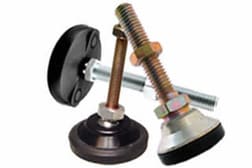
Are you planning to buy leveling feet for one or more machines in your business’s workplace? If so, you might be wondering whether to choose tapped or stud leveling feet. All types of leveling feet can stabilize the machines with which they are used while subsequently minimizing vibrations. Tapped and stud leveling feet aren’t the same, however. To determine which type is right for your business, you’ll need to familiarize yourself with the differences between tapped and stud leveling feet.
What Are Tapped Leveling Feet?
Tapped leveling feet are those that have a threaded shaft. They are designed specifically for use with a bolt. Bolts, of course, have exterior threading. You can twist tapped leveling feet onto a bolt. Assuming the bolts are connected to a machine, the leveling feet will stabilize the machine. All tapped leveling feet have a threaded or “tapped” shaft that supports a bolt.
What Are Stud Leveling Feet?
Stud leveling feet are those that feature a built-in bolt. The bolt or “stud” is connected to a machine to provide stabilization. You don’t have to twist them onto a separate bolt. Stud leveling feet already have a bolt attached to them, which connects them to a machine. Just align the bolt with the threaded shaft of a machine, followed by twisting the built-in bolt into the shaft.
Differences Between Tapped and Stud Leveling Feet
While they are both used to stabilize machines, tapped and stud leveling feet differ in a few key ways. The main difference is that the former type of leveling feet has a threaded shaft, whereas the latter type has a built-in bolt. Tapped leveling feet are essentially female leveling feet, whereas tapped are male leveling feet. All tapped leveling feet have an interior-threaded shaft, and all stud leveling feet have an exterior-threaded bolt.
Aside from their design nuances, there are other differences between tapped and stud leveling feet. Stud leveling feet, for example, support a higher range of adjustments than their tapped counterparts. You can adjust the position of both types of leveling feet. But you can finer-tune adjustments with stud leveling feet than tapped leveling feet.
Tapped and stud are the two most common types of leveling feet. They are both used to level and stabilize machines. Tapped leveling feet simply have a threaded shaft, whereas stud leveling feet have a built-in bolt. You can use either type to stabilize the machines in your business’s workplace.
